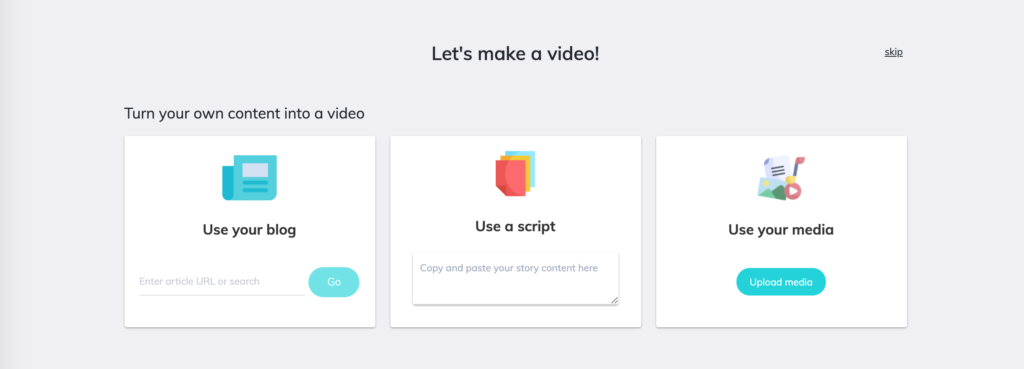
Tool Snapshot
| Price |
Free and paid versions are available |
| Learning |
Constructionism |
| Ease of Use |
★★★★✩ |
| Privacy |
★★★✩✩ |
| Accessibility |
★★✩✩✩ |
| Class Size |
Unlimited |
| Login |
Yes |
| ISTE*S |
Knowledge Constructor, Creative Communicator |
COPPA/
FERPA |
No COPPA/FERPA policy found. Check with your school IT administrator. |
Price
Lumen5 offers free, starter, premium, and business memberships (see the Lumen5 pricing page). Paid subscriptions run from $59 for a starter account to $149 a month for professional accounts.
ISTE Standards for Students
- Knowledge Constructor: Using Lumen5, students can curate multimodal resources to aid their learning.
- Creative Communicator: Lumen5 allows students to express their knowledge, insights, and ideas through video.
Lumen5 Overview Video
 Watch on YouTube
Watch on YouTube
Lumen5 & the SAMR Model
Dr. Ruben Puentedura’s SAMR model offers a lens for examining how technology is adopted in a classroom. As you strive to incorporate online tools into your classroom, we encourage you to use this model as an analytic tool. Here is an example of how Lumen5 might fit within the SAMR model:
- Substitution: Students watch a teacher-created Lumen5 video rather than a PowerPoint presentation.
- Augmentation: Students turn their blog posts into videos.
- Modification: Students quickly design and share videos with others via social media to solicit feedback on their understanding of content or text.
- Redefinition: Students critically evaluate the Lumen5 AI-created videos (including which text and images were selected and which words were highlighted) to assess the effectiveness, accuracy, and authenticity of using AI to express information.
Learning Activities
Math
Students can make their own videos explaining a math concept or problem. Students can watch peers’ videos for guidance when they get stuck on a concept or problem. Students can create videos about famous Mathematicians using curated texts from different websites.
Science
Students can identify different articles and blog posts about climate change and then use Lumen5 to make videos summarizing the main points and show them to the class.
English/Language Arts
Students can turn an act from a Shakespeare play into a video.
History/Social Studies
Students can turn a primary source text into a video.
Media Literacy
Students can analyze the visuals and text selected by Lumen5 when generating videos for blogs/online articles.
Other
Teachers can make videos for a variety of subjects for students to watch if they want an alternative to a traditional lecture.
Resources
How to Use Lumen5
1. Go to www.lumen5.com. Sign up and register for an account.

2. Tap on the “Create Video” button in the top right corner.

3. Choose which content you would like to use to create the video. You can paste a link to a blog or article, or insert your own text, or use your own media.

4. Choose from a large selection of video formats. You can make a video for Facebook, Instagram, Twitter, Snapchat, Youtube, LinkedIn, Pinterest, or a custom format.

5. Choose a theme.

6. Once your video has been generated, you can modify the text, visuals, highlights, and music.
Research
Goli, G., Babu, D. R., Laxmi, M. R., Kafila, & Rao, N. S. (2022, May). Image capturing and audio-video production to make five-shot and short film projects. In AIP Conference Proceedings (Vol. 2418, No. 1, p. 030072). AIP Publishing LLC.
Mahardika, I., Widiati, U., Bhastomi, Y., & Suryati, N. (2021). Camera Roll, Action! Non-specialist Undergraduate English Learners’ Perceptions of Using Video Production in Learning English. Journal of University Teaching & Learning Practice, 18(3), 08.
Norton, P., & Hathaway, D. (2010). Video production as an instructional strategy: Content learning and teacher practice. Contemporary Issues in Technology and Teacher Education, 10(1), 145-166.